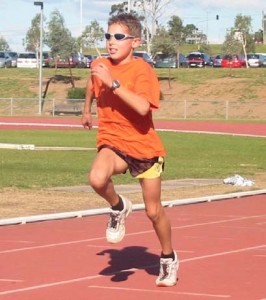Sprint Training for the Developing Athlete.
by Steve Bennett
B.Sc. (Physiology)
This article is designed for younger athletes who have done little training. It contains the main points of a long term approach.
It is initially much more important to improve balance, posture and stability of the trunk than it is to improve leg or arm strength.
Sprinters should develop overall fitness in a way that does not involve jogging. They should however BE ABLE to jog for a long distance without a problem. Overall fitness can be acquired through dance, medicine balls, skipping etc. A variety is best. Progressive circuit training is great.
Improving the ability to have the type of speed that comes with little effort is the goal. Athletes need to always practise relaxing when running. The is a skill that must be practised from a young age. RACING can often be a time of practising the bad habit of trying too hard especially in the very young. The ability to run fast and have it look easy is of the highest importance. The quality of an athlete that can have very fast steps is the first thing that needs to be developed from a young age.
Sprinters should not be instructed to run on their toes or to pump their arms high.
-It is better to develop a foot that is moving backward before impact and a foot carriage that is as close as possible to the shin (Dorsiflexion).
-Arms should be held with relaxed fingers and the main focus of effort should be a backward stroke. They should also not move very far forward from the body.
Maximum running speed is the most important quality to develop on a regular basis. This should be done with maximum speed experiences over short distances. eg Flying start 20-30m runs or Standing start runs over 30-40-50 or 60m. The athlete should perform these runs at maximum relaxed speed in sets of 3 with rests between of 3-5min where they stay active and between sets they should do other balance or trunk activities for maybe 10-15min. eg A maximum amount may be 3 sets of 3 runs over 60m. A good amount to do regularly (ie. 2-3 times/week) would be 2 sets of 3 runs over 40-50m. The athlete should never do more once they are getting slower within the session eg. If the times over 60m are 8.30, 8.20. 8.25, 8.30,8.60,8.80,9.00. Then they should have ended the session after the first obviosly slower run in the session and in the example that was the 8.60. Initially runners may be slowing after even the first run, but with training they may be able to 9 runs at the same speed.
The ability to develop the endurance to finish off a 100m or 200m race is best developed in races. Training at slower speeds to improve performance in these events is mostly of a little positive effect. Endurance is best developed while running at race speed If the athlete is really lacking in Speed Endurance at the end of these races they could do sessions like below:
- 2x 3 x Flying start 60m runs at high speed with rests of only 90s
- 4 x Flying100m very fast rests 3min.
The 400m event needs special training at the slower 400m race speed. The ability to relax and use little energy is important at race pace.
Some sessions to improve performance in the 400m are:
- 10 x Flying 100m at 400m race pace rests 3min
- 4 x 200m at 400m pace rests 5min
- 2 x 300 at 400m race pace rest 15min
- 400m athletes should also do more endurance training and can get by with more jogging especially in the off season. Maximum speed training is also of high importance.
It is important to have good foot function and for this reason it is useful for athletes to spend as much time as possible barefoot. Walking on sand is very good. Training should be conducted in very light simple shoes. Racing flats from the Runners Shop are much better than joggers for training in.
In Cold weather athletes must warm-up carefully and keep warm. Tights are great for training in as they maintain warmth during the frequent recoveries.
Training to improve muscle elasticity is very useful in all athletes eg. Games like Fly, Hop-Scotch, Skipping short distances, Leap frog and playful hopping and bouncing around are all great stimulation to the elastic qualities of muscle. Combining sensible amounts of these activities with balance challenging activites and relaxed movement practise would be ideal especially for very young athletes.
Any strength training should be restricted to the trunk until the athlete has optimal development of their posture and good levels of stability. Strength training is much more effective after this is developed anyway.
Young athletes lose flexibility as they grow and their bodies will naturally try to cheat to find ways to move to make up for the deficiency. Small amounts of perfect practise are better at decreasing the development of bad habits. Large amounts of high effort training during stages of decreased flexibillity and poor posture will result in the athlete learning a bad running style that will be more difficult to correct. Athletes need to have a smart stretching program designed persoannly for them during periods after faster growth. They need to be taught good posture and given feedback on what is good and bad posture when sitting, standing, walking and running. Most of our society have posture far below ideal.
Much more info is in my ebook Training Kids For Speed
